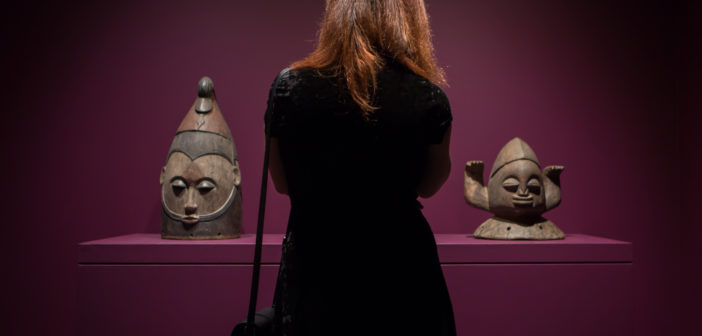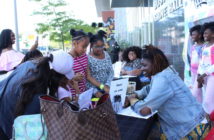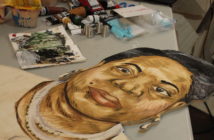“Identity intersects other times and places to survive histories we’ve come through.”- Awam Amkpa
Curated by Awam Amkpa, Professor, NYU Tisch School of the Arts, WOLE SOYINKA: Antiquities Across Times and Place is the first exhibition composed of African art since the Cooper Gallery first opened its doors in 2014. What started as an idea generated from conversations about aesthetics between a student and his mentor have blossomed into a gallery filled with wonder. In an effort to challenge the boundaries of history’s impact on the present, Amkpa juxtaposes works of contemporary Nigerian artists with excerpts from Soyinka’s vast collection of African relics.

Government Magic 2016 by Peju Alatisse 2016 All images courtesy of The Cooper Gallery photographed by Melissa Blackall.
The show opens with contemporary artist Osaretin Ighile’s gentle giant Oba Ovonramwen. The sculpture depicts a larger than life seated figure, referencing the last African King before the colonial rule of what is now known as Nigeria. The King’s strong form, yet tender features are swaddled in a colorful throne of banner-esque assemblages of reclaimed plastic, metal, and wood that evoke a life-like vibrancy rarely felt from monuments of fallen monarchs.
Illuminated objects in the hallways guide the visitors through the shadows of the gallery, bouncing from spotlight to spotlight on vessels, masks, figurines, and weapons of the past. Each one amplifying a moment within the same story: the cultural richness of Africa. Whether used by a farmer, warrior, or diviner no object is too small. “A common filmmaker skill is to use shadow as a means of summoning internal reflection,” says Amkpa. Collections themselves are byproducts of reflection and singling out objects of importance. In the case of Wole Soyinka, many of the works included in the exhibition have functioned as reference points for his writing and theatre practice that amplifies the stories of Nigerians and the cultural traditions that flow from generation to generation.

There are peeks of color in Osaretin Ighile's Oba Ovonramwen welcome to visitors. All images courtesy of The Cooper Gallery photographed by Melissa Blackall.
In addition to feeling the drama of the theatrical lighting, the undertone of dialogue shines in limitless connections that can be made when comparing and contrasting commentary on government, the environment, and lineage within the art. This runs parallel to the lives of the individuals who make the works and the spectrum of communities their identities are derived from. Amkpa believes that “ethnic purity is really an incredible fantasy because of the intensity of our interactions with one another. That’s why you find this kind of society where people are mostly multilingual and by default multicultural. You do find places where there are exceptions, but in general, most of the artists we look at are trying to expand their inter-ethnic relationships [through the creation of their work.”
Another powerful work in the exhibition is Peju Alatisse’s Abracabradabra- Government Magic. Alatisse’s criticism of Nigerian politics’ cruel “magic trick” that includes a black veil draped across a six-foot metal frame – housed within lies a dozen limp stone figures, entangled in metal thorns, and unable to break free. Further illustrating Amkpa’s point that “ for us [Africans]there is no discontinuity between past and present. Continuity is prevalent in Africa and in African Diaspora cultures. What is African about an African American person? African presence in the U.S. market and mythology today shows that you don’t just cut the past away.”
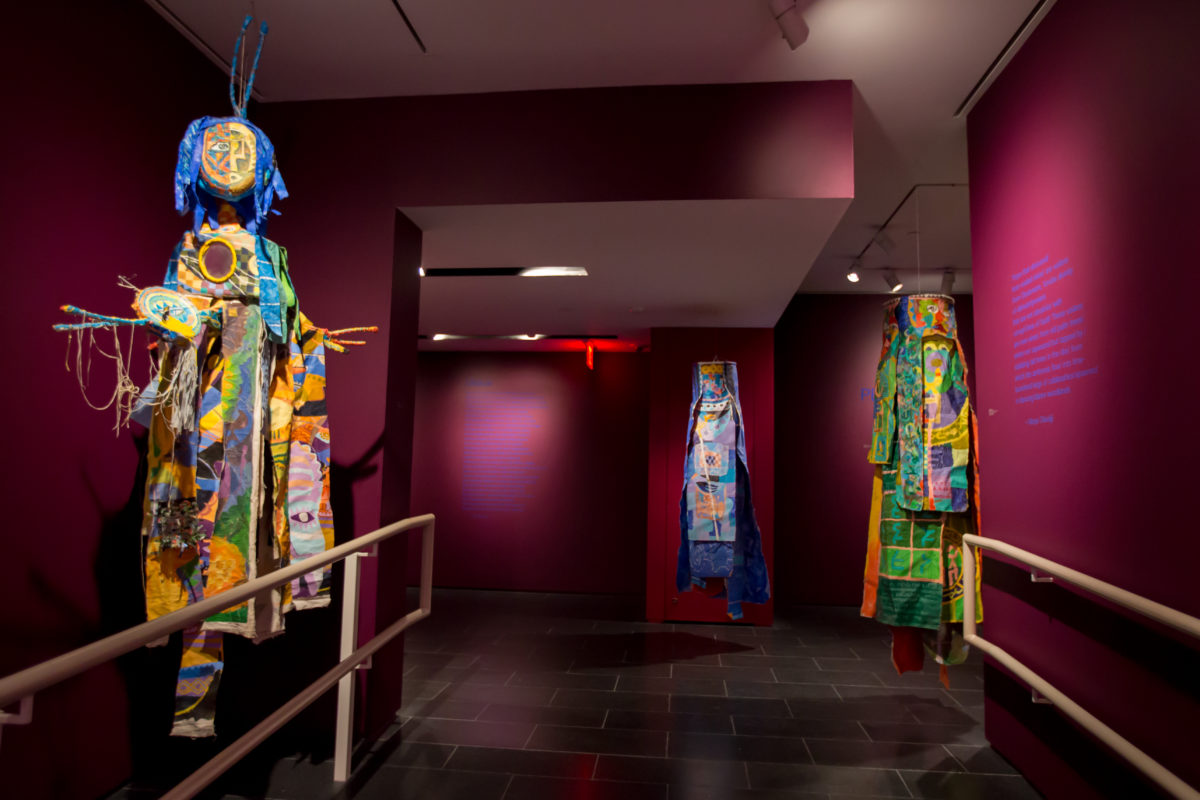
As you walk up the ramp Moyo Okediji's ehunhuns await you. All images courtesy of The Cooper Gallery photographed by Melissa Blackall.
Nobel Prize winning playwright Soyinka’s mentorship of Amkpa provides a backdrop of respect and admiration echoed in many of the curatorial choices throughout the space. Like the inclusion of Curator’s Confessions as wall text that share casual pieces of context for visitors to digest. Or the use of the purple-maroon for each wall of the gallery to reference the interiors of Wole’s home and “evoke the tropical warmth of the countries the artwork comes from.” The unseen being Amkpa’s familiarity with the context that some objects have in their culture of origin and connotations their function carries for people who engage with them. Which in turn, has led to his discretion in leaving behind some of Soyinka’s collection to evade a disruption of their spiritual potency. The most coy influence being the use of Wole’s play Death and The King’s Horseman to conceptually steer back and forth between the happenings during life and what that alludes to post death in the placement of each artwork from entrance to exit.
Upon engaging with the exhibition Ampka’s hope is that visitors realize “that there’s complexity coming out of Africa. We are not a simple, primitive people. Our history is diverse and our art reveals more than the books written about us. There’s lots of depth to how Africans want to represent themselves – It’s not about using a docent or guide as a crutch.
I want people to spend time with the objects to find the connections, much like listening to jazz and gaining the sensitivity to pick out the saxophone within the melody. It’s simultaneously deeply emotional, intellectual, and spiritual. ”
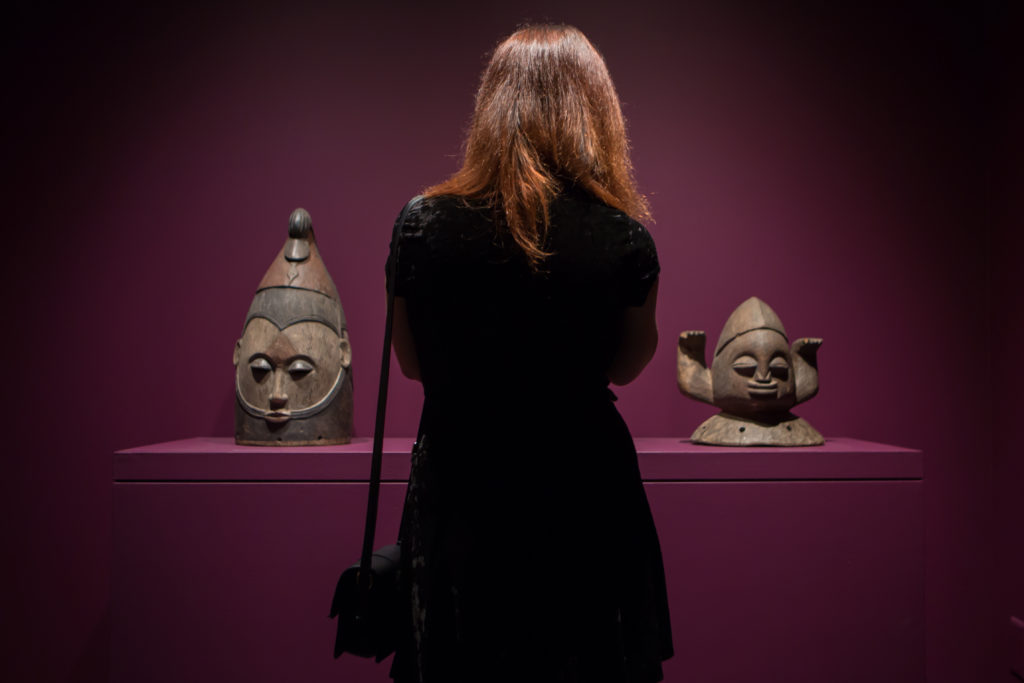
Woman looking at Igbo and Yoruba items All images courtesy of The Cooper Gallery photographed by Melissa Blackall.
WOLE SOYINKA: Antiquities Across Times and Place curated by Awam Amkpa, is on view through December 21, 2017 at The Cooper Gallery at the Hutchins Center for African & African American Research, Harvard University.
Works Cited:
Awam Amkpa, curatorial walk through, October 2017
Awam Amkpa interview with Chanel Thervil, October 2017

